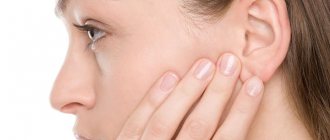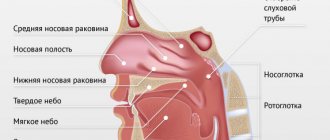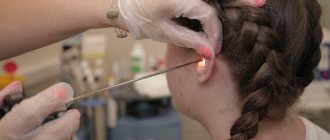Otolaryngologist for adults and children
Zubkov
Aleksey Aleksandrovich
20 years of experience
Otorhinolaryngologist of the first category, member of the European Rhinologic Society
Make an appointment
In the anatomical structure of the ear there is a section called the “labyrinth”, which is localized in the thickness of the bone and consists of interconnected and fluid-filled channels. The cochlea of the labyrinth is responsible for receiving sound vibrations with subsequent transformation into electrical impulses. And another important anatomical part is the vestibular canals, which are responsible for balance. The disease labyrinthitis is of an inflammatory nature and occurs as a result of an infectious lesion or as a result of a head or ear injury.
Symptoms and signs
The symptoms of labyrinthitis in adults are quite different. It can masquerade as osteochondrosis, impaired blood supply to the brain, or poor vascular function. The similarity of symptoms leads to erroneous diagnoses, which sometimes happens in medical practice. The following symptoms will help identify labyrinthitis:
- feeling of nausea and vomiting;
- imbalance, dizziness;
- moderate headache;
- sudden hearing loss;
- noise and rustling in the ears;
- nystagmus (twitching of the eyeballs).
Causes of the disease
Labyrinthitis symptoms in adults can occur for various reasons. It does not arise on its own. The disease is rather a complication of infectious and viral pathologies. The main reasons may be the following:
- otitis media with impaired outflow of purulent masses (inflammation of the middle ear);
- infectious diseases of the nasopharynx;
- injuries to the auditory analyzer;
- infectious diseases (flu, ARVI);
- history of meningitis or meningoencephalitis.
Publications in the media
Labyrinthitis is a group of inflammatory diseases of the inner ear, characterized by limited or diffuse damage to the peripheral parts of the auditory and vestibular analyzers.
Etiology • All types of microbial flora found in the middle ear cavity during acute or chronic purulent inflammation • Weakening of the body's reactivity.
Pathogenesis • In acute otitis, toxins enter the inner ear through the windows of the labyrinth - changes develop like diffuse serous labyrinthitis (later it can develop into acute purulent labyrinthitis); during a rapid course, the membranous labyrinth quickly collapses, all neuroepithelial formations of the inner ear die • In chronic purulent otitis with caries or cholesteatoma, a fistula is formed in the bone capsule of the labyrinth (most often in the ampulla of the lateral semicircular canal, less often in the area of the promontory of the tympanic cavity and the base of the stapes) •• Fistulas can be single or multiple, closed by a protective granulation shaft, therefore such labyrinths are called limited •• With a favorable course, the granulation shaft can turn into bone tissue; with an unfavorable course, chronic diffuse purulent labyrinthitis develops, accompanied by the death of nerve formations, which occurs more slowly than in the acute process .
Classification • By etiological factor •• Nonspecific •• Specific (tuberculous, syphilitic) • By pathogenesis •• Tympanogenic (otogenic) •• Meningogenic •• Hematogenous • According to the course and severity of clinical manifestations •• Acute •• Chronic (overt, latent) • By the length of the inflammatory process •• Limited •• Diffuse • By pathomorphological characteristics •• Serous •• Purulent •• Necrotic.
Clinical picture • Symptoms of damage to the auditory analyzer • Symptoms of damage to the vestibular analyzer • With serous labyrinthitis - hearing loss of a mixed type, mainly with damage to the sound-receiving apparatus, irritation of the vestibular apparatus or depression of vestibular function • With acute diffuse purulent labyrinthitis - pronounced symptoms of acute vestibular dysfunction in the form systemic dizziness, imbalance, accompanied by sudden autonomic disorders and spontaneous nystagmus. Complete destruction of the receptor endings of the auditory and vestibular analyzers quickly occurs. The likelihood of developing intracranial complications (meningitis, cerebellar abscess) is high • With limited labyrinthitis, the main symptom is fistula syndrome (the appearance of systemic dizziness, pressor nystagmus when toileting the external auditory canal or pressing on the tragus).
TREATMENT Diet . Limiting sodium-rich foods in the diet (limiting table salt, eating salt-free bread, salt substitutes - KCl, NH4Cl).
Conservative treatment - antibacterial, dehydration and detoxification agents. Surgical treatment • Elimination of a lesion in the middle ear - performing unloading operations such as anthromastoidotomy or radical sanitizing surgery • The need for surgical intervention on the labyrinth almost never arises at present, with the exception of sequestration of the labyrinth and labyrinthogenic cerebellar abscess.
Prognosis • After purulent labyrinthitis, persistent complete deafness usually remains with loss of functions of the vestibular apparatus. • After serous labyrinthitis, auditory and vestibular functions are preserved.
Prevention - timely diagnosis and rational treatment of purulent diseases of the middle ear. ICD-10 • H83 Other diseases of the inner ear
Types of disease and possible routes of infection
Labyrinthitis provokes the disease in different forms. To understand possible routes of infection, it is necessary to delve into the classification features. If we take the nature of the pathogen, we distinguish not only viral labyrinthitis, but also a number of others - bacterial and fungal. Otitis of various localizations is also the starting point. They cause purulent labyrinthitis, serous and necrotic. Such a clear classification helps to clearly distribute the types of the disease and analyze the initial focus. The inflammatory process is developing rapidly. According to this criterion, a distinction is made between diffuse and limited labyrinthitis. Each of them has individual development paths. Depending on the stage, namely the nature of the course of the disease, acute and chronic labyrinthitis are distinguished. But the mechanism of development of different types allows us to talk about the following forms of diagnoses: meningogenic, traumatic, tympanogenic and hematogenous.
Causes and pathogenesis of labyrinthitis
An inflammatory infection attacking the labyrinth can be caused by several reasons. In each case, internal otitis is caused by the movement of bacteria from the source of inflammation, but the reason why this happens may be different.
The source of inflammation that causes labyrinthitis can be otitis media, which destroys the connective tissue membranes of the ear, and this allows the infection to penetrate the labyrinth, causing suppuration and hearing impairment.
It is also quite likely that infection can penetrate through the cranial cavity, for example due to meningitis or influenza. The cause of such inflammation can be measles, tuberculosis, typhoid, syphilis, herpes, scarlet fever. Here, infection can also penetrate through the blood.
An ear injury, due to which the patient's eardrum was damaged, also causes purulent inflammation and labyrinthitis. This also includes those cases where the injury to the eardrum occurred due to the penetration of a foreign body, manipulation of a sharp object, or traumatic brain injury.
Risk factors for inflammatory processes in the ears
Labyrinthitis does not appear suddenly on its own. The disease depends on other factors. They are also the causes of the development of the pathological condition. With colds and flu, bacterial infections, microorganisms that can provoke purulent and inflammatory reactions spread throughout the body along with the bloodstream. This category includes streptococci, staphylococci, and adenoviruses. Distant foci produce pathogenic microorganisms and, together with the blood flow, deliver them to the cavity of the inner ear. Risk factors include the following diseases:
- arterial hypertension (hypertension in diabetes mellitus);
- hypoglycemia (inflated blood cholesterol readings);
- otitis of various types.
1.General information
A labyrinth is a collection of the most important elements of the organ of hearing, the so-called. The inner ear is responsible for acoustic perception and balance. The labyrinth is characterized by structural, anatomical and morphological complexity, which explains its name. Located in the temporal bone, the labyrinth is a complex of internal cavities (semicircular canals), the vestibule (lat. vestibulum, hence the name of the organ of balance - “vestibular apparatus”) and the cochlea - a spiral formation that is closest to all other elements of the labyrinth to the external auditory opening and is the organ of hearing itself, since it is here that sensitive to acoustic wave vibration fluids (endolymph), membranes, specific receptor cells and nerve endings are located that conduct the signal to the auditory center of the cerebral cortex.
According to the rules of word formation in medicine, the term “labyrinthitis” should mean inflammation of the labyrinth.
Indeed, this is the collective name for inflammatory processes in a given area of the body; sometimes the term “inflammation of the inner ear” is also used.
A must read! Help with treatment and hospitalization!
Complications in patients with labyrinthitis
The nature of the disease carries with it the risk of complications. They are mainly inflammatory in nature. Labyrinthitis causes complications due to the spread of the inflammatory process to nearby structures. From the inner ear it can pass into the fallopian canal. Given the location of the facial nerve in this area, the risk of peripheral neuritis increases. The list of complications includes mastoiditis with an infectious lesion of the mastoid process and petrositis with purulent inflammation in the area of the temporal bone.
Clinical picture
The main clinical manifestations of labyrinthitis are:
Friends! Timely and correct treatment will ensure you a speedy recovery!
- noise in the ear;
- significant hearing loss;
- dizziness;
- imbalance;
- any movement or turn of the head causes nausea;
- change in color of the skin on the face.
These symptoms can persist for a long time, from 2 to 3 weeks, or become a chronic form of labyrinthitis after the acute period of the disease has passed.
Meningococcal labyrinthitis:
Disorders of the vestibular apparatus are not clearly expressed, despite the fact that both labyrinths are affected. There is a significant hearing loss.
Tuberculous labyrinthitis:
Hearing loss occurs gradually, but constantly progresses. The course of the disease can be hidden, so labyrinthitis may not be recognized immediately.
Syphilitic labyrinthitis:
Suggests hearing impairment and dizziness due to fluid accumulated in the labyrinth. This form of the disease can be characterized by the complete disappearance of the functions of the labyrinth and damage to the facial nerve. In addition, syphilitic labyrinthitis may also imply an imperceptible hearing impairment that occurs gradually. In this case, the disease can be diagnosed only with the help of additional examination. In some cases, the course of syphilitic labyrinthitis, on the contrary, is characterized by the onset of a sharp deterioration in the functions of the labyrinth and, accordingly, the vestibular apparatus.
When to see a doctor
Acute, chronic, limited labyrinthitis or any other type of disease cannot be treated at home. If symptoms of the disease appear, you should immediately consult a doctor. Sudden loss or deterioration of hearing, dizziness and suspicious tinnitus are reasons to seek medical help. Time in the case of inflammatory diseases is the main factor in stabilizing the situation. Independent attempts at treatment will not bring a positive result, and delay can cause the disease to enter the chronic stage.
Prevention
Labyrinthitis can be prevented by the following measures:
- avoid ear and head injuries;
- promptly treat acute otitis media and other ENT diseases, as well as meningitis in children;
- Consult a doctor promptly if disturbing symptoms appear.
If you suspect a pathology of the organ of hearing and balance, we invite you for a consultation at the paid services department of NIKIO. The most experienced doctors work here and there is modern equipment for diagnosing and treating the disease. Early contact with a specialist will help preserve your hearing and health.
Diagnosis of labyrinthitis in patients
A competent diagnosis is the key to success on the patient’s path to recovery. Diagnosis begins with collecting anamnesis. The ENT listens to the patient's complaints and compares them with the general condition. This allows you to identify key directions for the further diagnostic process. To clarify the diagnosis, the patient may be prescribed the following procedures:
- audiometry (determining hearing acuity using the instrumental method);
- otoscopy and microotoscopy (diagnosis of hearing and examination of the eardrum);
- MRI, X-ray, CT (to identify pathologies in the brain);
- electronystagmography (analysis of eyeball movement).
Prescribing treatment after diagnosis
An ENT doctor at a clinic selects therapy depending on the type of disease and the extent of the spread of the purulent-inflammatory process. It all depends on the clinical picture. To facilitate the outflow of purulent and serous contents, a procedure is performed to drain the ear cavity. Labyrinthitis symptoms may be moderate. In the absence of a bacterial infection, treatment is symptomatic. For nausea, patients take antiemetic drugs. Antihistamines and sedatives are also prescribed to alleviate the condition. Bacterial labyrinthitis requires treatment with antibiotics. The choice depends on the type of pathogen, which is determined by the antibiogram. In case of complicated course of the disease, surgical interventions are used. It can be:
- vestibulotomy;
- plexustomy;
- chordostomy;
- endolymphatic shunting;
- laser destruction.
Treatment of labyrinthitis
Since the disease causes a wide range of symptoms, most of which are painful for the individual; affects an important organ; causes many complications, it is not surprising that its treatment is a comprehensive, systemic and complex process, which includes not only taking medications, but also regular examinations and procedures. Surgery is also possible. During the recovery period after an illness, hearing prosthetics is sometimes indicated.
Medicines prescribed for labyrinthitis are anti-inflammatory drugs, antibiotics, drugs to increase blood circulation, and neuroprotectors. Symptoms of the disease are relieved by ballataminal and betahistine, vestibulolytics.
Surgical intervention can be aimed at sanitation of the middle ear, plastic surgery of the labyrinth fistula, opening of the temporal skin pyramid, or even complete removal of the labyrinth with drainage of the cranial cavity.
Recovery after surgery may involve the need to install a hearing prosthesis to maintain the patient's current state of health and prevent deterioration in the ability to perceive sounds. To do this, either cochlear implantation is performed - an invasive manipulation that restores hearing. Or prosthetics are shown, and the selection and adjustment of the device is carried out by a hearing care specialist.
How to make an appointment with an otolaryngologist
You can make an appointment with the specialists of JSC "Medicine" (clinic of Academician Roitberg) on the website - the interactive form allows you to select a doctor by specialization or search for an employee of any department by name and surname. Each doctor’s schedule contains information about visiting days and hours available for patient visits.
Clinic administrators are ready to accept requests for an appointment or call a doctor at home by calling +7 (495) 775-73-60.
Convenient location on the territory of the central administrative district of Moscow (CAO) - 2nd Tverskoy-Yamskaya lane, building 10 - allows you to quickly reach the clinic from the Mayakovskaya, Novoslobodskaya, Tverskaya, Chekhovskaya and Belorusskaya metro stations .










